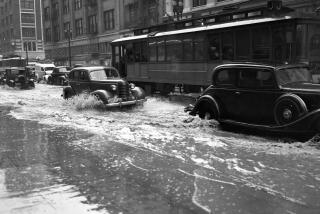The Rain Man : Solitary Life Suits Weather Observer Atop Mt. Wilson
The top man in Los Angeles weather circles doesn’t have a degree in meteorology. He doesn’t even have one of those fancy Doppler radar screens on his desk to watch for incoming storm clouds.
Lu Rarogiewicz doesn’t need any of that stuff. All he has to do is step outside his house next to Weathervane Drive atop Mt. Wilson and stick out his hand.
If he can see his fingertips through the clouds, that’s a good wintertime sign at his lonely weather post more than a mile above Los Angeles.
Rarogiewicz is a National Weather Service observer who for eight years has carefully recorded rainfall totals, temperature, wind speeds and cloud formations every six hours, seven days a week.
On Wednesday, he recorded it all for weather forecasters based in Oxnard.
Clouds engulfed his rooftop station at the 5,710-foot elevation in the morning. The sun came out shortly before noon. After lunch it started raining, then the temperature dropped close to freezing and it turned to sleet and finally to snow. There was thunder and lightning in the midafternoon, followed by a brief bit of sunshine before dark clouds blew in again at dusk.
Rarogiewicz’s life on the mountaintop may be lonely. But it’s rarely dull.
When he isn’t busy recording barometric pressure levels, he operates a tiny post office next to the eight-foot-wide weather station for the dozen or so others who also live in the Angeles National Forest and work at Mt. Wilson’s broadcast sites, its famed observatory, on road crews or for the forest service.
He’s on call for a Los Angeles television station, which occasionally sends him racing over to its transmitter building to tweak a nob here or take a power level reading there to keep its programs on the air.
*
He sometimes finds himself coming to the aid of tourists who drive to the mountaintop to gaze at the panorama of Los Angeles below--and then discover that the transmitters’ millions of watts of radiated power have knocked out their cars’ computerized engines.
“It took me three years of fussing around with my VCR to get it to work right due to the radio fields up here,” Rarogiewicz explained. “Being right under the transmitter towers, my television reception is lousy. And there’s no cable TV up here.”
On freezing days, when he climbs the 44 steps to his rooftop weather post, Rarogiewicz wears a hard hat over his parka hood to keep falling chunks of ice from the towers from knocking him out cold.
It’s usually plenty cold enough during the 4 a.m. readings. It sank to 10 degrees in December, 1990. Snow drifts 20 feet high sometimes occur; a snowfall four years ago marooned him for four days.
Rarogiewicz posts handwritten temperature levels and rainfall totals on the post office wall. More detailed reports--including precise descriptions of cloud formations he can see up to 200 miles away--are phoned to forecasters in Oxnard.
“He’s remarkable,” said Robert Baruffaldi, a National Weather Service meteorologist. “His remarks, the additive data about clouds and thunderstorms that he can see from up there, are priceless to us.”
Baruffaldi said Rarogiewicz sees more weather than others in the government’s network of paid and volunteer weather observers. And working alone, “he doesn’t get more than 5 1/2 hours of sleep at one time. He’s amazing.”
Rarogiewicz’s observations take about 15 minutes in good weather. But in nasty weather they take an hour. That’s when he must shovel his way through snow to his rooftop equipment and when collected snow must be melted before it can be measured.
When ice freezes the small motor that draws air over the outdoor thermometer, “I take my ex-wife’s hair dryer and defrost it,” he said.
Rarogiewicz, 60, an amateur astronomer, was struggling to become a computer consultant in Monrovia when a friend at the Mt. Wilson observatory mentioned that an elderly couple running the weather station were retiring. He decided to trade the urban sprawl for mountain solitude.
Rarogiewicz makes weekly food runs to a market 20 miles away in La Canada Flintridge. On nice days, he spends his free time hiking or riding his mountain bike on nearby trails. The bicycle has logged more than 2,000 miles, he said.
He uses a camera-equipped telescope to take stunning close-up pictures of Los Angeles high-rises looming through layers of marine fog and of distant sights such as the Point Loma lighthouse in San Diego. He also photographs the rare “green-flash” atmospheric phenomenon during sunrises and sunsets. “I plan to write a book about it,” he said.
Officials sometimes talk of automating his weather station, Rarogiewicz said. But that doesn’t worry him.
Doppler radar and other electronic weather-monitoring gear probably would never work among all the radio and television signals up there, he said, laughing.
More to Read
Sign up for Essential California
The most important California stories and recommendations in your inbox every morning.
You may occasionally receive promotional content from the Los Angeles Times.









